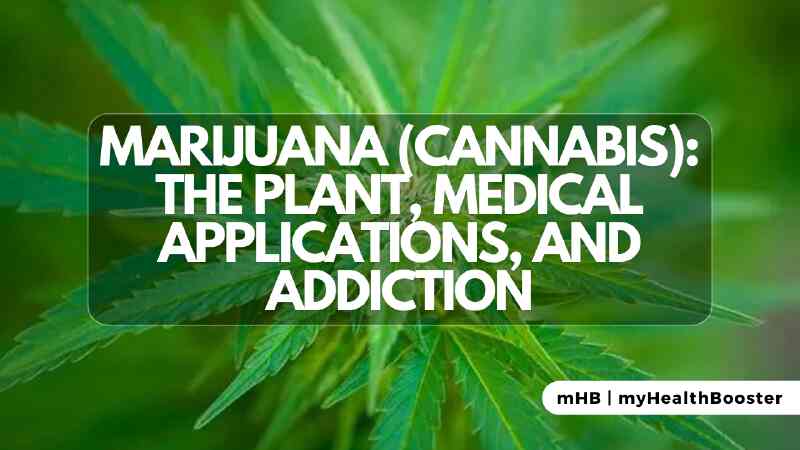Cannabis, scientifically known as Cannabis sativa, is a plant whose leaves, seeds, stems, and roots are consumed for the purpose of experiencing intoxication, commonly referred to as being “high.” While it contains numerous compounds, the primary psychoactive component is tetrahydrocannabinol (THC). Although medical marijuana is legal in certain U.S. states, it remains illegal in most jurisdictions. The abuse of marijuana, the most widely used illegal substance globally, has been associated with various health risks.
Medical Marijuana
Medical marijuana, also known as Marinol (Dronabinol), is a synthetic form of marijuana prescribed for specific health conditions. It is available in capsule form and is used to stimulate appetite in individuals with AIDS and manage nausea during cancer chemotherapy. However, it comes with physical and psychological side effects, and caution is advised, especially for those with mental health diagnoses.
Alternative Names and Types
Marijuana goes by various names, including pot, hemp, herb, reefer, ganja, and weed. Different forms, such as hashish, joints, blunts, and edibles like brownies, cater to diverse consumption preferences. The history of marijuana spans thousands of years, with its legalization for medical use sparking debates globally. Various strains exist, each tailored for specific purposes such as pain management or nausea reduction.
Effects on the Brain and Body
Marijuana abuse has numerous negative effects on cognitive functions, impacting learning and memory. Socially, it may lead to adverse outcomes for adolescents, including legal issues, pregnancy, and educational challenges. Long-term use can be associated with sexual dysfunction and an increased risk of certain cancers. Pregnant women exposed to marijuana may negatively impact fetal growth and cognitive development.
Treatment for Marijuana Abuse
Treatment for marijuana abuse typically involves outpatient programs utilizing behavioral therapies like motivational enhancement therapy (MET), cognitive-behavioral therapy (CBT), and contingency management (CM). Family-based therapies are also effective for adolescents. While no specific medication has been proven effective, antidepressants and oral THC may help manage withdrawal symptoms.
Prevention and Prognosis
Understanding risk factors, such as the availability of marijuana and engagement in negative behaviors, is crucial for prevention. Early substance use, including alcohol and tobacco, can serve as gateways to marijuana use. The prognosis for marijuana abuse recovery is challenging, with a high relapse rate, especially among those who initiate use at an early age. Vulnerability to mental health issues, including suicide attempts and psychosis, is associated with marijuana abuse.
Resources for Support
Various organizations provide support for individuals dealing with marijuana abuse, such as Codependents Anonymous, Kids Against Drugs, Marijuana Anonymous World Services, Narcotics Anonymous, National Council on Alcoholism and Drug Dependence, National Institute on Drug Abuse, and Substance Abuse & Mental Health Services Administration (SAMHSA).
Conclusion
Cannabis, with its complex history, medical applications, and potential for abuse, requires careful consideration. Educating individuals about the risks, providing effective treatments, and fostering preventive measures are essential components in addressing marijuana abuse and addiction.
References
- American Psychiatric Association. Diagnostic and Statistical Manual of Mental Disorders, Fourth Edition-Treatment Revision. 2001.
- American Psychiatric Association. Practice guideline for the treatment of patients with substance use disorders, second edition. In, American Psychiatric Association Practice Guidelines: Treatment of Patients With Substance Use Disorders 2006 May.
- Budney AJ, Roffman R, Stephens RS, Walker D. Marijuana dependence and its treatment. Addiction Science in Clinical Practice 2007 December; 4(1): 4-16.
- Callaway E. Regular marijuana usage robs men of sexual highs. Journal of Sexual Medicine 2009 August; 16: 2.
- Elkashef A, Vocci F, Huestis M, et al. Marijuana neurobiology and treatment. Substance Abuse 2008; 29(3): 17-29.
- Looby A, Earleywine M. Negative consequences associated with dependence in daily cannabis users. Substance Abuse Treatment and Prevention Policy 2007; 2: 3.
- Merriam Webster’s Dictionary 2011.
- National Institute on Drug Abuse. Gender and ethnic patterns in drug use among high school seniors 2003 August; 18(2).
- National Institute on Drug Abuse. Teen marijuana use increases, especially among eighth-graders 2010 December.
- New York Times Company. Marijuana and medical marijuana. The New York Times 2011 August 6.
- PDR.net. Physicians’ Desk Reference. 2011. http://www.pdr.net.
- Pierre JM. Psychosis associated with medicinal marijuana: risk vs. benefits of medicinal cannabis use. American Journal of Psychiatry 2010 May; 167: 598-599.
- Tarter RE, Vanyukov M, Kirisci L, Reynolds M, Clark DB. Predictors of marijuana use in adolescents before and after licit drug use: examination of the gateway hypothesis. American Journal of Psychiatry 2006 December; 163: 2134-2140.
- Williams JS. Cognitive Deficits in marijuana smokers persist after use stops. National Institute on Drug Abuse 2003 December;18(5).
- Zhang ZF, Morgenstern H, Spitz MR, et al. Marijuana use and increased risk of squamous cell carcinoma of the head and neck. Cancer Epidemiological Biomarkers Preview 1999 December; 8(12): 1071-1078.
- Zickler P. Marijuana-related disorders, but not prevalence of use, rise over past decade. National Institute on Drug Abuse 2005 May; 19(6).
- Zickler P. Twin study links marijuana abuse, suicide and depression. National Institute on Drug Abuse 2005 August; 20(2).
